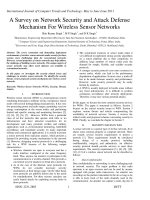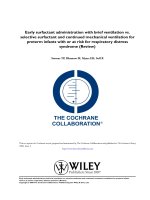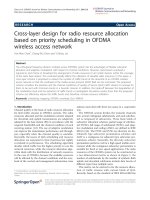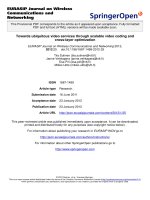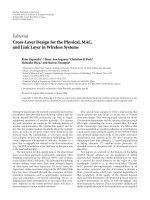channel adaptive technologies and cross layer designs for wireless systems with multiple antennas
Bạn đang xem bản rút gọn của tài liệu. Xem và tải ngay bản đầy đủ của tài liệu tại đây (8.71 MB, 544 trang )
Channel-Adaptive
Technologies and
Cross-Layer Designs
for Wireless
Systems with
Multiple Antennas
Theory and Applications
Vincent K. N. Lau
The Hong Kong University of Science and Technology
Yu Kwong Ricky Kwok
The University of Hong Kong
A JOHN WILEY & SONS, INC., PUBLICATION
Channel-Adaptive
Technologies and
Cross-Layer Designs
for Wireless
Systems with
Multiple Antennas
Channel-Adaptive
Technologies and
Cross-Layer Designs
for Wireless
Systems with
Multiple Antennas
Theory and Applications
Vincent K. N. Lau
The Hong Kong University of Science and Technology
Yu Kwong Ricky Kwok
The University of Hong Kong
A JOHN WILEY & SONS, INC., PUBLICATION
Copyright © 2006 by John Wiley & Sons, Inc. All rights reserved.
Published by John Wiley & Sons, Inc., Hoboken, New Jersey.
Published simultaneously in Canada.
No part of this publication may be reproduced, stored in a retrieval system, or transmitted in
any form or by any means, electronic, mechanical, photocopying, recording, scanning, or
otherwise, except as permitted under Section 107 or 108 of the 1976 United States Copyright
Act, without either the prior written permission of the Publisher, or authorization through
payment of the appropriate per-copy fee to the Copyright Clearance Center, Inc., 222
Rosewood Drive, Danvers, MA 01923, (978) 750-8400, fax (978) 646-8600, or on the web at
www.copyright.com. Requests to the Publisher for permission should be addressed to the
Permissions Department, John Wiley & Sons, Inc., 111 River Street, Hoboken, NJ 07030,
(201) 748-6011, fax (201) 748-6008, e-mail:
Limit of Liability/Disclaimer of Warranty: While the publisher and author have used their best
efforts in preparing this book, they make no representations or warranties with respect to the
accuracy or completeness of the contents of this book and specifically disclaim any implied
warranties of merchantability or fitness for a particular purpose. No warranty may be created
ore extended by sales representatives or written sales materials. The advice and strategies
contained herin may not be suitable for your situation. You should consult with a professional
where appropriate. Neither the publisher nor author shall be liable for any loss of profit or any
other commercial damages, including but not limited to special, incidental, consequential, or
other damages.
For general information on our other products and services please contact our Customer Care
Department with the U.S. at 877-762-2974, outside the U.S. at 317-572-3993 or fax 317-572-4002.
Wiley also publishes its books in a variety of electronic formats. Some content that appears in
print, however, may not be available in electronic format.
Library of Congress Cataloging-in-Publication Data:
Lau, Vincent K. N.
Channel adaptive technologies and cross layer designs for wireless systems with multiple
antennas : theory and applications / Vincent K. N. Lau, Yu-Kwong Ricky Kwok.
p. cm.
ISBN-13: 978-0-471-64865-9
ISBN-10: 0-471-64865-5
1. Wireless communication systems—Design and construction. I. Kwok, Yu-Kwong
Ricky. II. Title.
TK5103.4.L56 2006 2005043673
Printed in the United States of America.
10987654321
To our wives: Elvina and Fion
CONTENTS
List of Figures xvii
List of Tables xxv
Preface xxvii
Acknowledgments xxxv
PART 1 THEORY 1
Chapter 1 Basic Concepts in Wireless Communications 3
1.1 Overview 3
1.2 Wireless Channel Models 3
1.2.1 AWGN Channel Model 4
1.2.2 Linear Time-Varying Deterministic Spatial Channel 4
1.2.3 The Random Channels 12
1.2.4 Frequency-Flat Fading Channels 17
1.2.5 Frequency-Selective Fading Channels 18
1.3 Equivalence of Continuous-Time and Discrete-Time Models 19
1.3.1 Concepts of Signal Space 20
1.3.2 Sufficient Statistics 20
1.3.3 Discrete-Time Signal Model—Flat Fading 20
1.3.4 Discrete-Time Channel Model—Frequency-Selective
Fading 28
1.4 Fundamentals of Information Theory 30
1.4.1 Entropy and Mutual Information 31
1.4.2 Shannon’s Channel Coding Theorem 36
1.4.3 Examples of Channel Capacity 46
1.5 Summary 54
Exercises 54
vii
Chapter 2 MIMO Link with Perfect Channel
State Information 59
2.1 Overview 59
2.2 Mathematical Model of the MIMO Link 60
2.2.1 Probabilistic Channels with States 61
2.2.2 General Transmission and CSI Feedback Model 64
2.2.3 Adaptive-Channel Encoding and Decoding 65
2.2.4 Transmit Power Constraint 66
2.2.5 Causal Feedback Constraint 67
2.3 Ergodic and Outage Channel Capacity 67
2.3.1 Ergodic Capacity 68
2.3.2 Outage Capacity 68
2.4 Channel Capacity with No CSIT and No CSIR 69
2.4.1 Fast Flat Fading MIMO Channels 70
2.4.2 Block Fading Channels 70
2.5 Channel Capacity with Perfect CSIR 72
2.5.1 Block Fading Channels 73
2.5.2 Fast Flat Fading MIMO Channels 76
2.5.3 Effect of Antenna Correlation on Ergodic MIMO
Capacity 81
2.5.4 Slow Flat Fading MIMO Channels 87
2.6 Channel Capacity with Perfect CSIT Only 89
2.6.1 Discrete Block Fading Channels 91
2.6.2 Discrete Channel with Three States 93
2.6.3 Fast Flat Fading MIMO Channels 94
2.6.4 Slow Flat Fading MIMO Channels 94
2.7 Channel Capacity with Perfect CSIR and Perfect CSIT 95
2.7.1 Fast Flat Fading MIMO Channels 96
2.7.2 Slow Flat Fading MIMO Channels 100
2.8 Summary 101
Exercises 103
Chapter 3 MIMO Link with Imperfect Channel
State Information 107
3.1 Overview 107
3.2 Effect of Imperfect CSI Estimation 108
3.2.1 CSI Estimation for MIMO Channels 108
3.2.2 Capacity Bounds of MIMO Link 109
3.3 Effect of Limited Feedback—Optimizing for SNR 111
3.3.1 Introduction to Optimizing Effective SNR 112
3.3.2 Grassmannian Line Packing 112
viii CONTENTS
CONTENTS ix
3.3.3 Grassmannian Precoding for MIMO Systems—Spatial
Diversity 115
3.3.4 Grassmannian Precoding for MIMO Systems—Spatial
Multiplexing 119
3.4 Effect of Limited Feedback—Optimizing for Ergodic Capacity 124
3.4.1 Channel Capacity with Partial CSIT 124
3.4.2 Coding Theorem with Partial CSIT 125
3.4.3 Equivalence with Vector Quantization Problem 130
3.4.4 Fast Flat Fading MIMO Channels 130
3.4.5 Lloyd’s Algorithm 132
3.4.6 Approximate Closed-Form Solution for Step 1 133
3.4.7 Complexity of the Online Adaptation Strategy 134
3.4.8 MMSE-SIC Receiver Structure 135
3.4.9 Numerical Results and Discussion 136
3.5 Summary 138
Exercises 140
Chapter 4 Spacetime Coding and Layered Spacetime Coding
for MIMO with Perfect Channel State Information 143
4.1 Overview 143
4.2 Design of MIMO Links with Perfect CSIR 144
4.2.1 Spacetime Coding—Spatial Diversity 147
4.2.2 Layered Spacetime Coding—Spatial Multiplexing 154
4.2.3 Receiver Designs for Layered Spacetime Codes 159
4.2.4 Optimal Architecture for Fast Flat Fading Channels 166
4.2.5 Optimal Architecture for Slow Flat Fading Channels 168
4.2.6 Fundamental Tradeoff between Spatial Diversity and
Spatial Multiplexing 170
4.3 Switching Threshold Design for MIMO Adaptation with Perfect CSIT
and Perfect CSIR 175
4.3.1 MIMO Transmitter and Adaptation Designs 176
4.3.2 Optimization Problem—Quasistatic Fading Channels 178
4.3.3 Equivalence to the Classical Vector Quantization
Problem 179
4.3.4 Results and Discussion 180
4.4 Summary 183
Exercises 184
Chapter 5 MIMO Constellation Design with Imperfect
Channel State Information 189
5.1 Overview 189
5.2 Constellation Design for MIMO Channels with Imperfect CSIR 191
5.2.1 System Model 191
5.2.2 Design Criteria Based on Kullback–Leibler Distance 191
5.2.3 Constellation Design Optimization 195
5.2.4 Single-Transmit Antenna Example 197
5.2.5 Multitransmit Antenna Example 200
5.3 Spacetime Coding for MIMO Channels with Imperfect CSIR 200
5.3.1 Overview of Coded Modulation in AWGN Channels 203
5.3.2 Coded Modulation Design for MIMO Channels with
Imperfect CSIR 207
5.4 Summary 211
Chapter 6 Cross-Layer Scheduling for Multiuser Systems
with Multiple Antennas 215
6.1 Overview 215
6.2 Multiuser System Performance 217
6.2.1 Examples of System Utility 218
6.2.2 Definition of Network Capacity 220
6.2.3 Definition of Network Coverage 220
6.3 System Models 222
6.3.1 Multiuser MIMO Channel Model 223
6.3.2 Multiuser Downlink Physical Layer Model 224
6.3.3 MAC Layer Model 229
6.4 Cross-Layer Optimization with Perfect CSIT 229
6.4.1 Capacity-Optimized Scheduler Design 229
6.4.2 Coverage-Optimized Scheduler Design 231
6.4.3 Common Framework for Both Capacity-Optimized
and Coverage-Optimized Scheduling 231
6.4.4 Optimal Solution—Single-Antenna Systems 232
6.4.5 Optimal Solution—Multiple-Antenna Systems with
OTBF Processing 234
6.5 Low-Complexity Scheduling Algorithms 236
6.5.1 Suboptimal Solution A—Greedy Algorithm 236
6.5.2 Suboptimal Solution B—Genetic Algorithm 237
6.6 Results and Discussion 239
6.6.1 System Capacity Performance 239
6.6.2 Proportional Fairness Performance 241
6.6.3 Coverage Performance 242
6.6.4 Tradeoff between Capacity and Coverage 243
6.6.5 Efficiency of Multiuser Diversity 244
6.6.6 Efficiency of Spatial Multiplexing 244
6.6.7 Complexity Comparisons of Various Cross-Layer
Algorithms 245
6.7 Cross-Layer Scheduling with Imperfect Channel State
Information 245
x CONTENTS
6.7.1 Multiuser Physical Layer Model with Imperfect CSIT 247
6.7.2 System Utility Function 248
6.7.3 The Scheduling Problem Formulation 249
6.7.4 The Optimal Scheduling Solution 249
6.7.5 Suboptimal Solution 251
6.7.6 Numerical Results 253
6.8 Summary 253
Appendix 6A: Proof of Lemma 6.2 257
Appendix 6B: Calculation of Weights 257
Appendix 6C: Proof of Lemma 6.3 258
Appendix 6D: Proof of Lemma 6.4 259
Appendix 6E: Proof of Lemma 1.10 259
Appendix 6F: Proof of Lemma 6.5 259
Appendix 6G: Optimal Power Allocation for Network
Capacity Utility 261
Appendix 6H: Asymptotic Distribution of S
k
262
Exercises 264
PART 2 DESIGN EXAMPLES AND APPLICATIONS 267
Chapter 7 Review of MAC Layer Design for
Wireless Systems 269
7.1 Overview 269
7.2 TDMA-Based MAC Layer Design 272
7.2.1 ALOHA 272
7.2.2 Slotted ALOHA 272
7.2.3 PRMA 273
7.2.4 TDMA with Request Subframe 273
7.3 CDMA-Based MAC Layer Design 275
7.4 Issues in Request Scheduling 277
7.5 Design Example—a Jointly Adaptive TDMA MAC Protocol 279
7.5.1 Overview of TDMA MAC Protocol Design 279
7.5.2 Synergistic Channel-Adaptive Multiple Access 280
7.6 Design Example—a Jointly Adaptive CDMA MAC Protocol 290
7.6.1 Channel Adaptation in CDMA Systems 290
7.6.2 Optimal and Near-Optimal Approaches 291
7.6.3 Approaches that Maintain Fairness 293
7.6.4 User-Oriented Heuristics 294
7.7 Performance Comparisons 295
7.8 Summary 303
Exercises 303
CONTENTS xi
Chapter 8 Channel-Adaptive Wireless Fair Scheduling 307
8.1 Overview 307
8.2 Scheduling Model 308
8.2.1 Fluid Fair Queueing 308
8.2.2 Service Model 308
8.2.3 A Motivating Example 309
8.3 Design Framework 310
8.3.1 Error-Free Service Model 310
8.3.2 Lead–Lag Model 310
8.3.3 Compensation Model 311
8.3.4 Slot Queue and Packet Queue 312
8.4 Fairness Notions 312
8.4.1 Effort Fair and Outcome Fair 312
8.4.2 Fairness Notions for Wireline Networks 313
8.4.3 Fairness Notions for Wireless Networks 314
8.4.4 Channel-Adaptive Fairness 318
8.4.5 Comparison with Other Fairness Notions 319
8.5 Wireless Packet Scheduling Algorithms 319
8.5.1 Idealized Wireless Fair Queueing (IWFQ) 319
8.5.2 Channel-Condition-Independent Fair Queueing (CIFQ) 320
8.5.3 Server-Based Fairness Approach (SBFA) 320
8.5.4 Wireless Fair Service (WFS) 321
8.5.5 Utility-Based Opportunistic Scheduling 321
8.5.6 Channel-Adaptive Fair Queueing 322
8.6 Numerical Examples 328
8.6.1 Parameters 328
8.6.2 Scenario 1 329
8.6.3 Scenario 2 331
8.6.4 Scenario 3 332
8.6.5 Scenario 4 332
8.7 Channel-Adaptive Scheduling for CDMA Systems 334
8.7.1 Code Allocation in Multicode CDMA Systems 335
8.7.2 CAFQ for CDMA Systems 335
8.8 Summary 337
Exercises 338
Chapter 9 Packet-Switched Data Services in
W-CDMA Systems 341
9.1 Overview 341
9.2 UMTS Architecture 343
9.2.1 Radio Interface 345
9.2.2 PHY Layer 347
xii CONTENTS
9.2.3 MAC Layer 356
9.2.4 RLC Layer 357
9.2.5 RRC Layer 360
9.3 Packet-Switched Connections in UMTS (Rel 99) 363
9.3.1 Radio Bearer for Packet-Switched Users 364
9.3.2 Setup of Packet-Switched Connection 365
9.3.3 Scheduling Algorithms 367
9.3.4 Performance 369
9.4 Packet Scheduling in HSDPA (Rel 5) 370
9.4.1 Key Enabling Technologies in HSDPA 370
9.4.2 Scheduling Algorithms and Performance 374
9.4.3 Continued Evolution 376
9.5 Summary 376
Exercises 377
PART 3 ADVANCED TOPICS 379
Chapter 10 Cross-Layer Scheduling for
Wideband Systems 381
10.1 Overview 381
10.2 Overview of DS-CDMA/MISO and OFDM/MISO
Systems 383
10.2.1 Multiuser Physical Layer Model of
DS-CDMA/MISO Systems 384
10.2.2 Physical Layer Model of OFDMA/MISO Systems 390
10.3 Cross-Layer Scheduling Design for DS-CDMA/MISO and
OFDMA/MISO Systems 397
10.3.1 Cross-Layer Design for DS-CDMA/MISO Systems 398
10.3.2 Cross-Layer Design for OFDMA/MISO Systems 398
10.4 Performance Comparisons of DS-CDMA- and
OFDM-Based Systems 400
10.4.1 Performance of DS-CDMA/MISO Systems 401
10.4.2 Performance of OFDMA/MISO Systems 401
10.4.3 Comparisons of DS-CDMA/MISO and
OFDMA/MISO Systems 404
10.5 Implementation Issues of OFDMA System 405
10.5.1 Downlink versus Uplink 405
10.5.2 Signal Model 406
10.5.3 Effect of Timing Offsets 409
10.5.4 Effect of Frequency Offsets 410
10.6 Summary 411
Exercises 413
CONTENTS xiii
Chapter 11 Cross-Layer Scheduling Design Based on
Queueing Theory and Information Theory 417
11.1 Overview 417
11.1.1 Cross-Layer Scheduling Model 420
11.2 Multiuser Physical Layer Model 423
11.2.1 Graph Model 424
11.2.2 on/off Channel Model 427
11.2.3 Information-Theoretic Model 429
11.3 Motivations for Cross-Layer Scheduling in Multiuser
Wireless Networks 431
11.4 Stability Region 434
11.4.1 Stability Region of Time-Invariant Physical Layer 435
11.4.2 Stability Region of Stochastic Physical Layer 437
11.4.3 Scheduling Design for Stability 441
11.5 Cross-Layer Scheduler Design for Delay Minimization 444
11.5.1 Problem Formulation 445
11.5.2 Optimal Solution 447
11.5.3 Description of LQHPR Policy 451
11.5.4 Performance of an Example System 452
11.6 Summary 454
Appendix 11A: Proof of Theorem 11.1 on Stability Region
of Deterministic Physical Layer 455
Appendix 11B: Proof of Theorem 11.2 on Stability Region
of Stochastic Physical layer 456
Appendix 11C: Proof of Theorem 11.3 on Throughput
Optimality of MW Scheduling 457
Appendix 11D: Proof of Theorem 11.5 on Throughput
Optimality of EXP Scheduling 458
Appendix 11E: Conditions for Stability of a Stochastic
Process 460
Appendix 11F: Proof of Theorem 11.6 on Throughput
Optimality of Tse–Hanly Policy 461
Exercises 462
Chapter 12 Channel-Adaptive Ad Hoc Routing 465
12.1 Overview 465
12.2 Background 465
12.3 Overview of Ad Hoc Routing Protocols 467
12.3.1 AODV Protocol 467
12.3.2 DSDV Protocol 467
12.3.3 DSR Protocol 468
12.3.4 ABR Protocol 469
12.3.5 Link State Routing Protocol 469
xiv CONTENTS
12.4 Receiver-Initiated Channel-Adaptive (RICA) Routing 470
12.4.1 Channel Model 470
12.4.2 Route Discovery 471
12.4.3 Broadcast of CSI Checking Packets 473
12.4.4 Route Maintenance 475
12.4.5 Route Updating 476
12.4.6 Comparison with Other Protocols 479
12.5 Performance Results 479
12.5.1 Simulation Environment 479
12.5.2 Average End-to-End Delay 482
12.5.3 Successful Percentage of Packet Delivery 483
12.5.4 Routing Control Overhead 485
12.5.5 Scalability 486
12.5.6 Varying Offered Traffic Load 486
12.5.7 Quality of Routes 487
12.5.8 Observations in the Simulations 488
12.5.9 Critiques on the Four Protocols 490
12.6 Summary 491
Exercises 491
References 493
Topic Index 503
CONTENTS xv
LIST OF FIGURES
P.1. Architecture of multiantenna transmitter without feedback. xxviii
P.2. Layered architecture of communication systems. xxix
P.3. Architecture of MIMO transmitter with feedback of
channel state. xxx
P.4. Architecture of MAC layer with channel state feedback. xxxi
1.1. Delay spread and coherence bandwidth. 7
1.2. Doppler spread and coherence time. 8
1.3. Illustration of angle spread and coherence distance. 8
1.4. Summary of fading channels. 11
1.5. Time–frequency autocorrelation and delay–Doppler
spectrum. 14
1.6. Illustration of space–frequency autocorrelation and
delay–wavenumber spectrum. 16
1.7. Illustration of tapped-delay-line frequency-selective
channel model. 19
1.8. Illustration of signal constellations. 23
1.9. Optimal detector structure based on matched filtering
for fading channels with zero ISI transmit pulse. 26
1.10. Illustration of mutual information. 33
1.11. Illustration of data processing inequality. Preprocessing
at the receiver and postprocessing at the transmitter
cannot increase mutual information; C
2
£ C
1
.35
1.12. Various modes of random sequence convergence. 37
1.13. Illustration of a typical set. 40
1.14. Illustration of a jointly typical set. 41
1.15. Channel encoder. 42
1.16. Generic channel. 42
1.17. Illustration of channel decoder. 43
1.18. An M-input, Q-output discrete memoryless channel. 47
1.19. Binary symmetric channel. 48
1.20. Binary erasure channel. 48
1.21. Discrete-input continuous-output channel. 49
xvii
1.22. A plot of bandwidth efficiency versus E
b
/
h
0
for AWGN
channel. 53
2.1. Block fading channel model. 63
2.2. A general model of transmission and causal partial
feedback strategies for block fading channels. 64
2.3. General structure of an adaptive channel encoder. 65
2.4. General structure of an adaptive channel decoder. 66
2.5. Binary block fading channel with two states. 71
2.6. Block diagram of equivalent-channel model with CSIR only. 72
2.7. Optimal transmitter structure of fast fading MIMO channels
with perfect CSIR. 79
2.8. MIMO ergodic capacity versus number of antennas [126],
with SNR ranges of 0–35 dB. 81
2.9. Asymptotic ergodic capacity versus number of antennas
[126], with SNR ranges of 0–35 dB in 5-dB increments. 82
2.10. Rayleigh fading MIMO channel model with correlated
fading. 83
2.11. Ergodic MIMO capacity with perfect CSIR at various
antenna separations and angle spreads [140]; SNR = 20 dB
and n
T
= n
R
= 4. 84
2.12. Line-of-sight MIMO channel model in free space. 85
2.13. Outage capacity for MIMO channels with CSIR [126]. 88
2.14. Illustration of channel-adaptive transmitter with perfect
CSIT. 89
2.15. Block diagram of the equivalent-channel model with full
CSIT only. 90
2.16. A discrete memoryless channel with CSIT. 92
2.17. Capacity achieving configuration for the equivalent
channel.93
2.18. Ergodic capacity of MIMO channels with ideal CSIT and
CSIR. 99
2.19. A summary of various channel capacities in fading channels. 102
3.1. Lower bound and upper bound of 4 ¥ 4 MIMO ergodic
capacity versus SNR at various CSIR estimation errors
s
2
e
. 111
3.2. A table of the best packing [123] found for N £ 50 lines
in G(m, 1) where m £ 9. The values indicate the maximum
angle separations. 114
3.3. Block diagram of a MIMO system for spatial diversity. 115
3.4. Table of generated codebook based on Grassmannian
search for n
T
= 2,3 and Q = 2,4,8. 118
3.5. Capacity comparison of unquantized beamforming with
three Grassmannian beamforming schemes [93] for a
4 ¥ 2 MIMO system. 118
3.6. Block diagram of MIMO systems with spatial
multiplexing. 119
xviii LIST OF FIGURES
LIST OF FIGURES xix
3.7. Symbol error probability of 4 ¥ 2 MIMO link based on
chordal distance precoding with 6 bits of feedback [94]. 123
3.8. Equivalent-channel model of the communication system
with partial CSIT U and partial CSIR V. 124
3.9. MIMO transmission strategy with feedback link capacity
constraint. 131
3.10. Ergodic channel capacity versus average SNR of
2 ¥ 2 system at various feedback channel capacities
C
fb
= 0,1,2,∞. 137
3.11. Forward channel capacity versus average SNR with ideal
CSIR for 2 ¥ 1 and 4 ¥ 1 systems and C
fb
= 0,1,2,3,4,∞. 139
4.1. Structure of a generic spacetime code at the transmitter. 145
4.2. Illustration of spatial diversity and spatial multiplexing. 146
4.3. Block diagram of transmit diversity based on the Alamouti
code. 148
4.4. Block diagram of the V-BLAST transmitter. 155
4.5. Block diagram of the H-BLAST transmitter. 157
4.6. Block diagram of the D-BLAST transmitter. 158
4.7. Spatial interleaving of hybrid H-BLAST/D-BLAST. 158
4.8. Illustration of threaded LST design. 159
4.9. Illustration of zero-forcing receiver. 161
4.10. Illustration of iterative LST receiver. 165
4.11. Comparison of the vector codebooks between random
generation and H-BLAST architectures. 167
4.12. Tradeoff between spatial diversity and spatial multiplexing
in slow MIMO fading channels. 173
4.13. Illustration of MIMO transmitter adaptation. 177
4.14. Performance of adaptive MIMO systems with n
T
= n
R
= 2
and perfect CSIT. 181
5.1. Illustration of 2D unitary constellation with n
T
= 1. 196
5.2. Illustration of the optimal constellation of point sizes
8 and 16 for n
T
= n
R
= 1 and P
0
= 10 dB. 198
5.3. Average symbol error probability versus n
R
of the optimal
constellation of point sizes 8 and 16 for n
T
= 1, P
0
= 10, and
s
2
e
= 0.5. 199
5.4. Average symbol error probability versus SNR of the
optimal constellation design for n
T
= n
R
= 2,
s
2
e
= 0.05, 0.1
and uncoded throughput of 4 bits per channel use. 201
5.5. Average symbol error probability versus SNR of the
optimal constellation design for n
T
= n
R
= 2,
s
2
e
= 0.00,
0.01 and uncoded throughput of 8 bits per channel use. 202
5.6. Set partitioning of an 8PSK signal set. 204
5.7. General structure of encoder/modulalor for trellis-coded
modulation. 205
5.8. Uncoded 4PSK and trellis-coded 8PSK modulations. 207
5.9. Illustration of 16-point constellation designed for MIMO
channels with imperfect CSIR;
s
2
e
= 0.01 and SNR = 20 dB.
This constellation is designed to optimize the uncoded
error performance for T = 1. 210
5.10. Performance comparison between the partially coherent
design and the coherent design in the presence of
imperfect CSIR. 212
6.1. Illustration of distributed spatial multiplexing. 216
6.2. Illustration of worst-case outage. 222
6.3. System model with multiantenna base station. 223
6.4. Capacity region of multiuser downlink channels with
n
T
= 1. 225
6.5. Orthogonal transmit beamforming (OTBF) strategy with
multiple antennas. 226
6.6. Block diagrams of the MAC layer. 230
6.7. Illustration of the utility functions u
1
(w), u
2
(w), and
u
3
(w) for single-antenna broadcast channels with
|h
1
|>|h
2
|>|h
3
|. 234
6.8. Illustration of crossover operation in genetic algorithm. 238
6.9. Performance of maximal throughput downlink schedulers
versus SNR for multiple-antenna systems. 240
6.10. Performance of proportional fair downlink schedulers
versus SNR for multiple-antenna systems. 241
6.11. Illustration of fairness. Cumulative distribution function
(cdf) of mobile data rate at SNR = 10 dB and n
T
= 2. 242
6.12. Minimum scheduled data rate (bps/Hz) versus cell radius
at various Q = 1, ,6.Total transmit power of the base
station is 30 dBm, path loss exponent is 4, and the total
number of users is 10. 243
6.13. Tradeoff between the network capacity (sum of scheduled
data rate) and the network coverage (minimum scheduled
data rate) and at low and high SNRs. 244
6.14. Total system capacity versus K and n
T
at SNR = 10 dB. 245
6.15. Total network capacity (bps/Hz) versus cell radius at
various Q = 1, ,6 andn
T
= 6. The transmit power at
the base station is 30 dBm, path loss exponent is 4, and
the total number of users is 10. 246
6.16. Total network goodput (bps/Hz) versus n
T
at
s
2
e
=
(0,0.05,0.1), K = 10, and SNR = 10 dB. 254
6.17. A comparison of the total network goodput (bps/Hz)
versus n
T
on optimal scheduler with optimal power and rate
allocation, genetic scheduler with short-term SINR scaling,
greedy scheduler with short-term SINR scaling, and
round-robin scheduler with short-term SINR scaling at
s
2
e
= (0,0.05,0.1), K = 10, and SNR = 10 dB. 255
xx LIST OF FIGURES
7.1. A simple practical protocol stack in which the MAC layer,
divided into the request collection sublayer and the request
scheduling sublayer, is situated at level 2. 270
7.2. A simple taxonomy of different practical user separation
methods classified as coordinated and uncoordinated
approaches. 271
7.3. Conceptual illustration of the ALOHA protocol—devices
B and C collide when they attempt to transmit at about
the same time. 272
7.4. Conceptual illustration of the slotted ALOHA
protocol—devices B and C collide when they attempt to
transmit at exactly the same timeslot. 273
7.5. Conceptual illustration of the PRMA protocol. Device
A already reserves timeslots 3 and n, while device D already
reserves timeslot n - 1. Blank boxes denote unoccupied slots.
In the first frame, devices B and C successfully transmit their
data, and, as such, reserve timeslots 2 and 4, respectively. 274
7.6. Conceptual illustration of a TDMA protocol with request
subframe—devices B and C, having successfully transmitted
requests in the request subframe, are assigned (via a
downlinkFDD or TDD frame) to transmit data in time-slots
2 and 4, respectively. 274
7.7. A scenario in which the soft-handoff active set of a data
user consists of cells 0, 1, and 2 but not cell 3. 276
7.8. A partial taxonomy of TDMA-based MAC protocols. 279
7.9. Conceptual models of different forms of interaction
between the physical and MAC layers. 281
7.10. A conceptual block diagram of the variable-throughput
channel-adaptive physical layer. 283
7.11. BER and throughput of ABICM scheme. 283
7.12. Frame structures of the SCAMA protocol for CBR, VBR,
and ABR users. 285
7.13. Key operations of the SCAMA protocol. 287
7.14. Information (CSI or VBR demands) updating mechanism
for backlog requests. 289
7.15. Block diagram of the variable throughput adaptive
physical layer for a CDMA system. 291
7.16. Number of SCHs available on the downlink with varying
distances from the base station. 298
7.17. Downlink link coverage area as a function of the number
of SCHs allocated. 299
7.18. Data request admission probabilities on the uplink. 300
7.19. Voice outage probabilities on the uplink. 301
7.20. Average delay and throughput of data requests with 20
voice users and adjacent-cell load of 75%. 302
LIST OF FIGURES xxi
8.1. Variations of D in CIFQ and CAFQ. 330
8.2. Comparison between CS-WFQ and CAFQ. 331
8.3. Performance of CAFQ and CIFQ with various values
of punish factor. 333
8.4. Performance of CIFQ and CS-WFQ with CAF incorporated. 334
9.1. A high-level view of the UMTS architecture, composed of
the user equipment (UE), radio network controller (RNC),
node B, home location register (HLR), visitor location
register (VLR), mobile switching center (MSC), gateway
MSC, serving GPRS support node (SGSN), and gateway
GPRS support node (GGSN). 343
9.2. The radio interface protocol stack in UMTS. 345
9.3. UMTS user plane protocol architecture. 346
9.4. UMTS control plane protocol architecture. 347
9.5. Channelization code and scrambling code in UMTS. 347
9.6. Orthogonal variable-spreading factor (OVSF) codes. 348
9.7. Three layers of channels in UMTS. 350
9.8. Multiplexing of several transport channels into a single
CCTrCh in the physical layer. 352
9.9. Structure of P-SCH and S-SCH for cell search. 353
9.10. Multiplexing of DPDCH and DPCCH in downlink and
uplink. 354
9.11. Tables of spreading factor and bit rates in DPCH. 355
9.12. A summary of transport channel mappings in UMTS. 356
9.13. Three components of the MAC layer in the UE and the
UTRAN. 357
9.14. The architecture of the RLC layer. 358
9.15. Illustration of the components and mechanisms involved
in the RLC-acknowledged mode. 359
9.16. Protocol architecture of the RRC layer. 360
9.17. Interactions between the RRC layer and other protocol
components. 361
9.18. State transition diagram of RRC layer 362
9.19. A summary of transport channel mappings to support
data radio bearer in UMTS. 365
9.20. An example of packet-switched data connection setup
in UMTS with low traffic volume. 366
9.21. A schematic diagram illustrating the scheduling mechanism
in UMTS Rel 99. 367
9.22. An example of transport channel reconfiguration due to
an increase of downlink traffic volume. 368
9.23. An example of RRC state changes in the lifetime of a
packet-switched data connection. 368
9.24. Dynamic range of AMC for single-code and multicode
HSDPA systems. 372
xxii LIST OF FIGURES
9.25. A schematic diagram illustrating the scheduling mechanism
(HSDPA) in UMTS Rel 5. 374
9.26. Interchannel operation of HSDPA scheduling. 375
10.1. Principle of DS-CDMA spreading. 384
10.2. Base station architecture of DS-CDMA/MISO transmitter
with n
T
antennas. 385
10.3. RAKE receiver processing of multiuser DS-CDMA/MISO
systems. 388
10.4. Illustration of OFDM symbol in the frequency domain. 390
10.5. Time-domain windowing and its effect on the power spectral
density of OFDM signals. 392
10.6. Architecture of OFDM systems based on IDFT and DFT. 393
10.7. Base station architecture of OFDMA/MISO systems with
n
T
transmit antennas. 395
10.8. Normalized network capacity (bps/Hz) of DS-CDMA/MISO
systems. 402
10.9. Normalized bit rate versus SNR and n
f
, n
T
= 3, K = 10, and
L
p
= 16. 403
10.10. Performance comparison of OFDMA/MISO and
DS-CDMA/MISO for K = 32, L
p
= 16, and n
T
= 3. 404
10.11. Mobile transmitter of the OFDMA system. 406
10.12. Base station receiver of the OFDMA system. 406
10.13. OFDMA timing offset requirement with respect to ISI. 410
11.1. Generic optimization model of cross-layer scheduling. 421
11.2. Generic feasible region of multiuser physical layer. 424
11.3. Illustration of graph model quoted from Reference 148. 425
11.4. The on/off channel model. 427
11.5. A counterexample showing that water filling neither
guarantees stability of the queue nor gives maximum
throughput. The packet arrival process and the channel
connectivity process have periodic structures with a period
of four timeslots. (a) Packet arrivals for users 1 and 2;
(b) channel connectivity profile (white square means on
state); (c) MTLB policy; (d) (pure water filling) maximal
instantaneous throughput policy
p
; (e) queue occupancy
over time—queue lengths for users U
1
and U
2
under
(b
1
,b
2
) and under (b
*
1
, b
*
2
). Under policy
p
, queue of user
U
2
(b
2
) is building up over time. (Example extracted from
Reference 69.) 434
11.6. Illustration of capacity region and stability region for a
two-user time-invariant channel. 437
11.7. Illustration of capacity region for multiantenna base station
n
T
= 2 with K = 2 using zero-forcing processing at the
transmitter (note that the average of the convex hulls
denotes the stability region). 440
LIST OF FIGURES xxiii
